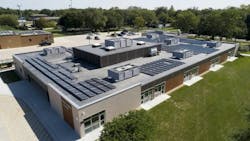Achieving a net-zero K-12 facility is a team effort
Designing a net-zero energy building is always a challenge, but renovating an existing school and applying for grants to make the project happen is another challenge entirely. IMEG recently had the opportunity to do just that, delivering a school district’s first net-zero facility.
When the Park View Early Learning Center in Mount Prospect, IL, was chosen to house the River Trails School District 26 kindergarten, preschool, and administration office, it needed to be renovated for the first time since its construction in 1965. The facility’s failing systems and outdated infrastructure were no longer meeting the district’s needs, so it was redesigned and renamed Prairie Trails School. Following in the footsteps of other energy-efficient schools in the district—four of which earned ENERGY STAR® certification—the new early learning center was designed for optimized indoor air quality and building comfort.
IMEG evaluated various HVAC and envelope options after conducting an energy model of the existing building and testing strategies and their impact on energy use and operational costs. The team ultimately designed an extremely tight and energy efficient envelope and an all-electric HVAC system with a variable refrigerant flow system coupled with dedicated outdoor air systems that meet the Passive House requirements for energy-efficient and comfortable indoor spaces.
In order to offset the costs of the highly sustainable renovation, the school pursued a $2 million grant from the Illinois Clean Energy Community Foundation (ICECF), which requires the building to use net-zero energy. IMEG worked closely with FGM Architects, River Trail School District 26, Trane, and a Passive House consultant to predict energy use and how much electricity would be generated by the photovoltaic system, properly size the system, and then apply for the grant.
The school initially received half of the grant at the beginning of the project. The team is now tracking the energy use data and trends in the completed building—adjusting usage as needed to continue to consume less energy than the photovoltaic system produces—and prove that the building is net zero.
Other strategies employed to help the design achieve net zero include running the systems at a reduced rate when the building is unoccupied and keeping a strict schedule for the building automation systems. For example, the gymnasium systems run at a reduced rate not only when the building is unoccupied, but also during normal school hours when no students are in the space.
The school will receive the remaining grant funds once the design has proved to be net zero for a full year. Tracking began in March 2022 and is showing positive trends upon initial evaluation.

